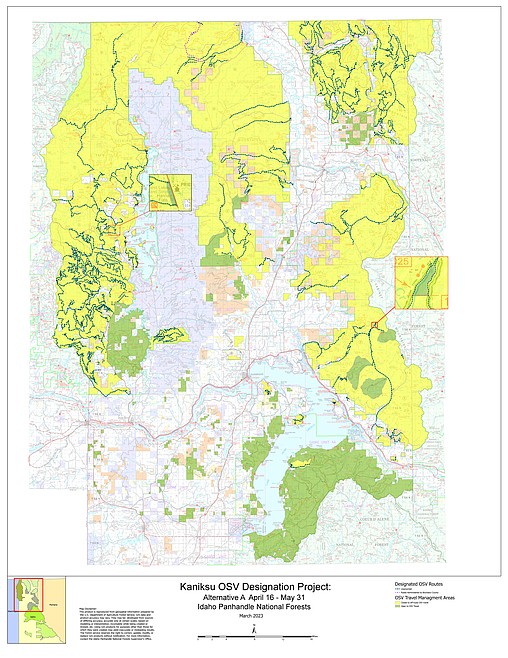Public input sought on proposed OSV project
The Idaho Panhandle National Forests held a virtual town hall Wednesday evening for its proposed action to designate over snow vehicle (OSV) routes in the northern Idaho region.
The project, which is in the very early stages of planning, will designate routes and areas to be open to OSV use in the Bonners Ferry, Priest Lake and Sandpoint – or Kaniksu – ranger districts of the Idaho Panhandle National Forests, which are three of the most popular OSV areas in Idaho. Through this new project, some areas will be completely off limits to OSVs, some will be open year round and other sections will only be available seasonally.
Forest Service officials said they hope these seasonal closures will help mitigate the negative effect on sensitive wildlife habitats with these new boundaries as many animals on the Endangered Species list living in the region while still allowing the public to enjoy the area on OSVs such as snowmobiles.
“We’re not meeting all our recovery goals for the ecosystems being affected here,” wildlife biologist Brett Lyndaker said.
While a few different ecosystems are being affected, Lyndaker said the main wildlife in consideration for this proposed project are the local grizzly bears. Bears tend to emerge from their dens – which are usually located above 4,000 feet – between April and May. Because of the warmer temperatures in lower regions, this timeframe is also typically when the most OSV traffic reaches those altitudes.
Lyndaker said this can disturb denned bears into being too afraid to come out as well as scare emerging bears away from the areas they tend to traverse.
“Adults can usually move away from the noise and be fine,” he said. “But if the cubs get separated from the sow, a lot of bad things can happen and that’s what we’re trying to prevent.”
Some areas would be closed from April 1 through roughly May 31 to allow grizzlies time to emerge from their dens comfortably and move along on their own without being scared off. After that time period, a number of those areas are able to be reopened for year-round OSV use.
The proposed project will increase the acreage of OSV use in the three districts from 746,296 acres to 770,165 acres. This increase will still allow for plenty of recreation space even while certain areas are closed seasonally for wildlife or restoration projects. The project will also create 18 more miles of groomed OSV trails for visitors to enjoy while reducing the amount of miles of groomed trail by 50.
Maps of the proposed project area can be found at www.fs.usda.gov/project/?project=53091. During the town hall, project manager Kaleigh Maze said some individuals were having issues with the maps appearing highly pixelated.
“The maps themselves are quite complicated,” Maze said. “To have them show up as super high resolution would make them too big to upload to the website.”
While the maps should be showing up at a higher resolution now, Maze said downloading each map to a computer as a pdf or printing them out should fix the problem.
“If you do that, you should be able to zoom in very, very closely and should be able to get rid of that granular issue that you’re having,” she said.
The Forest Service is highly encouraging public feedback on the proposed project to make sure they cover all areas of concern for both OSV users and nature lovers. The comment period will be open until the end of the day on April 27. Commenters can leave positive or negative feedback on the project website at cara.fs2c.usda.gov/Public//CommentInput?Project=53091.

